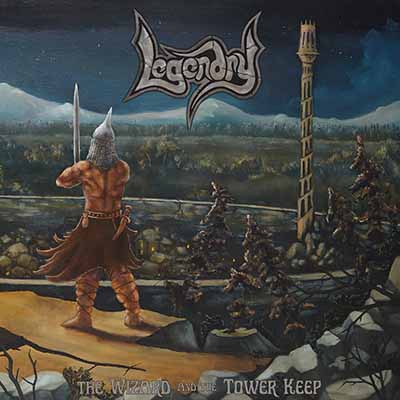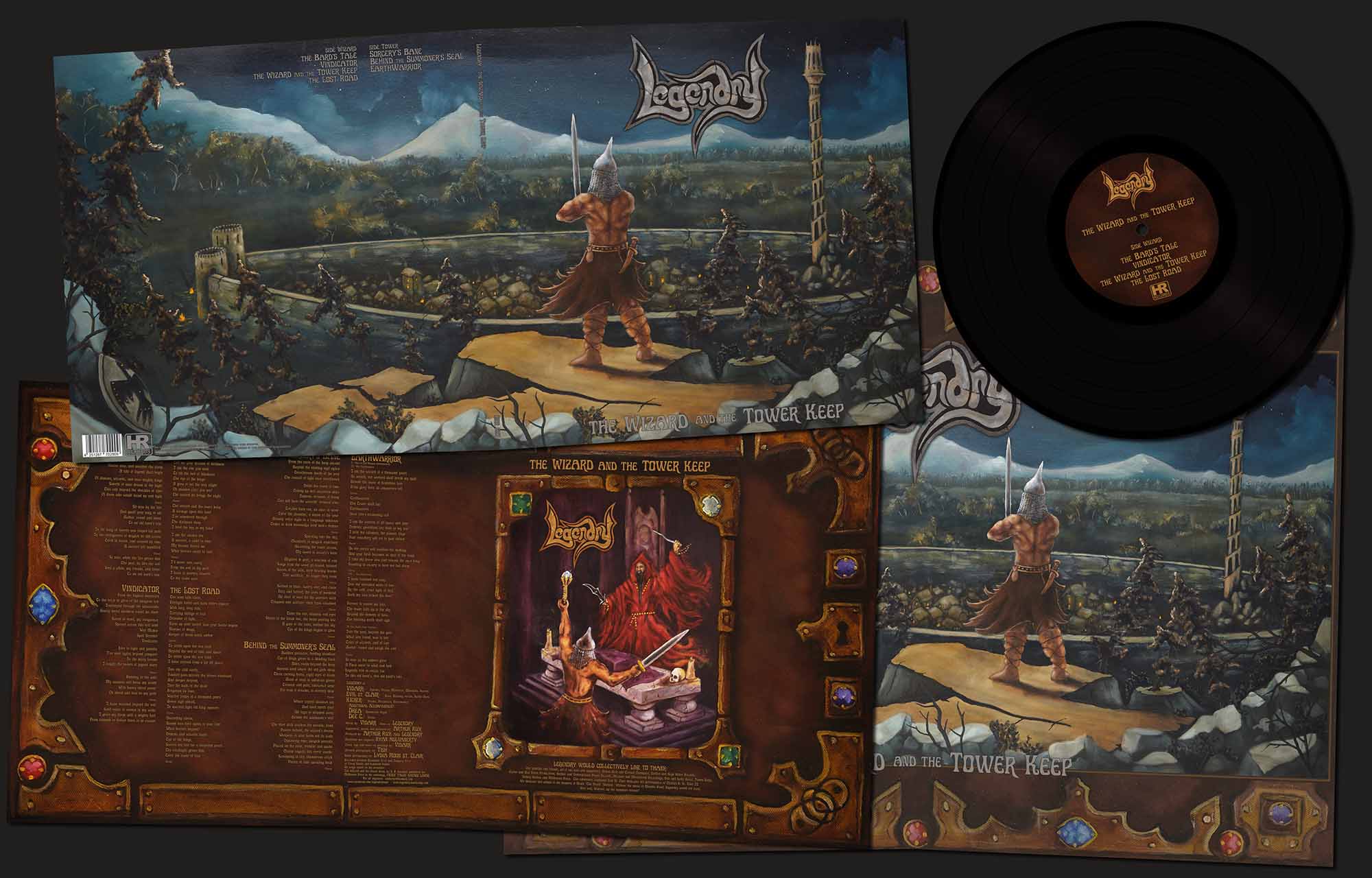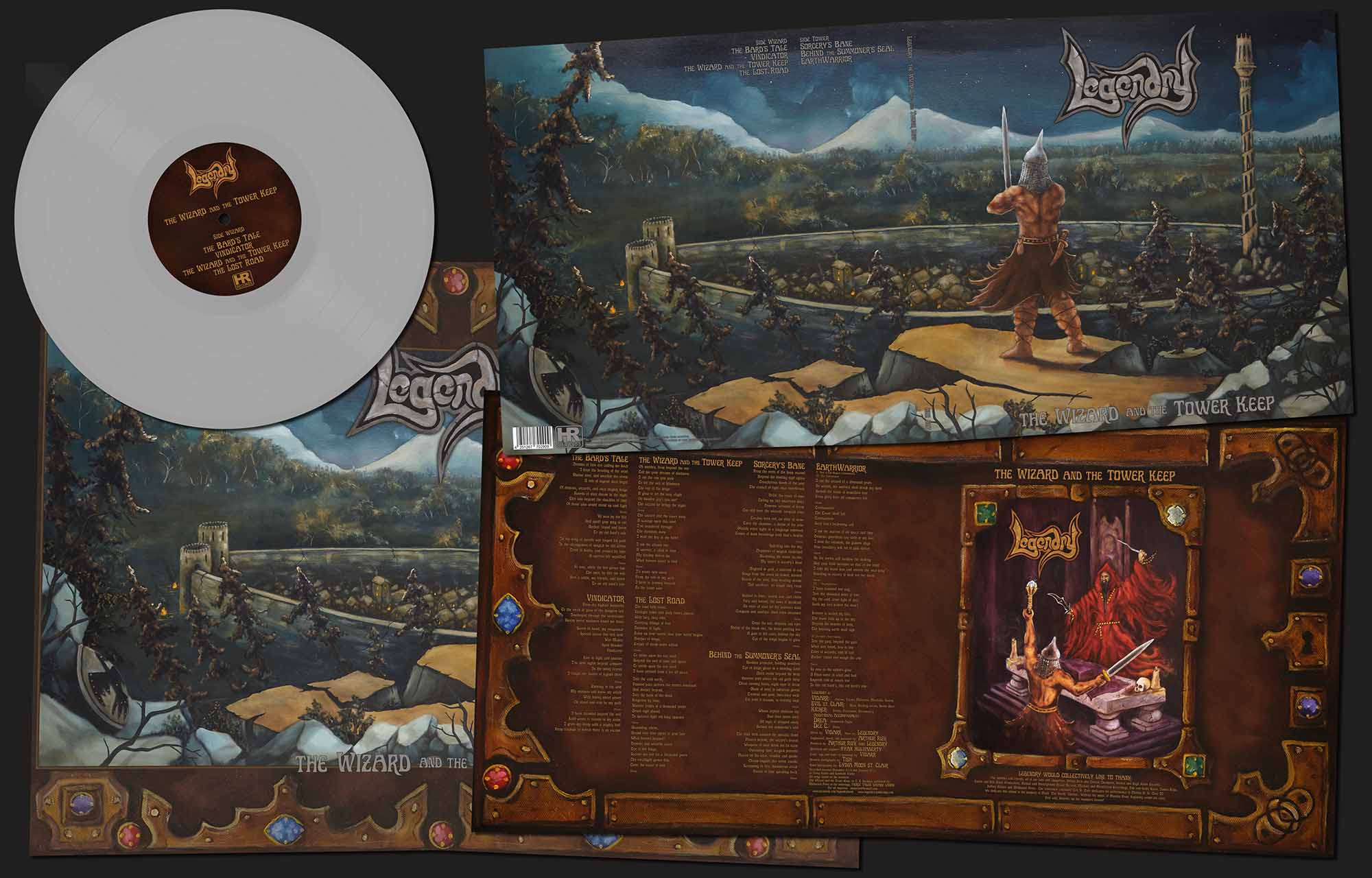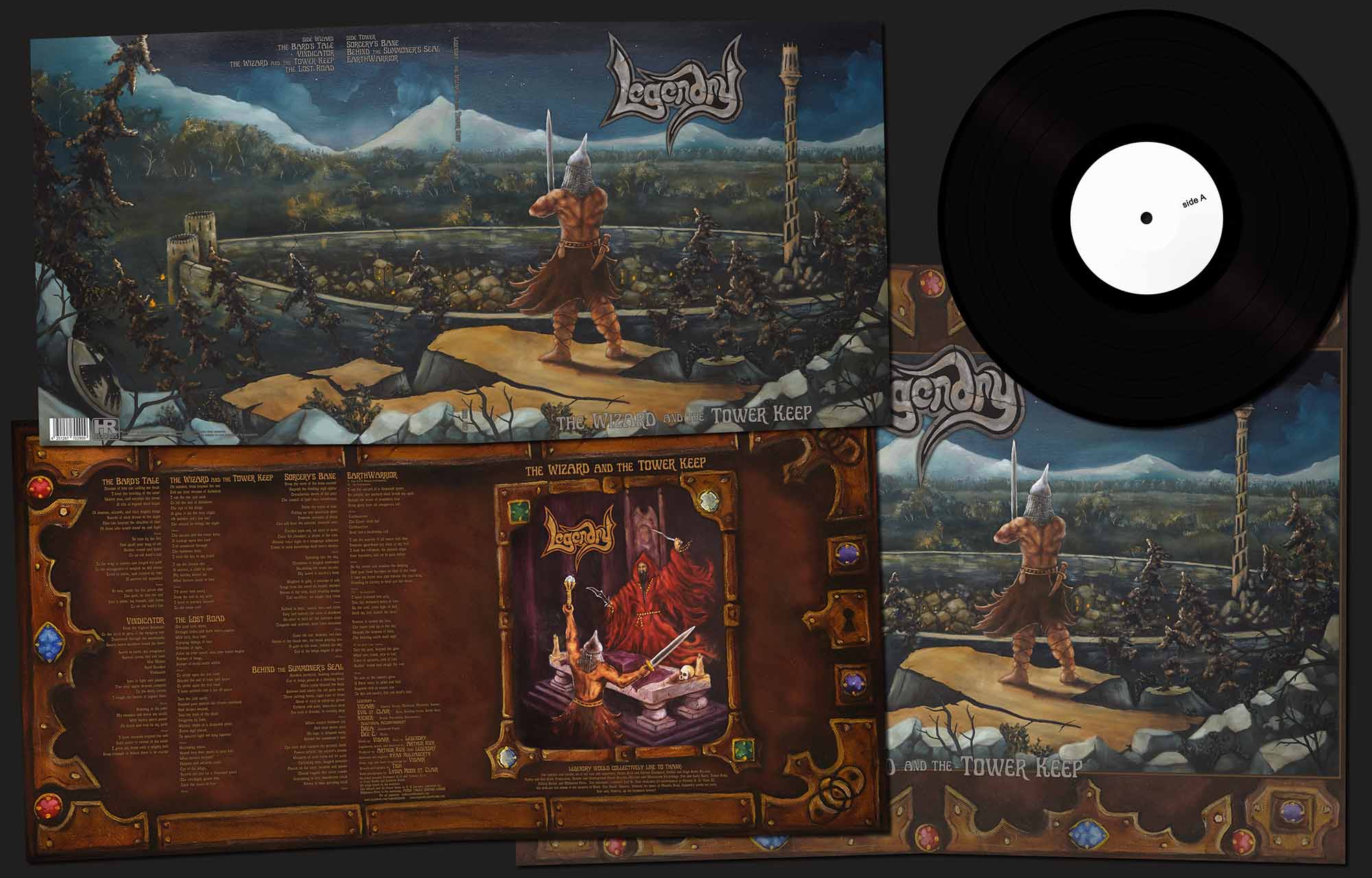 | ||||
| LEGENDRY - The Wizard and the Tower Keep LP | |
HRR 687, ltd 500, 200 x black + 300 x silver vinyl, gatefold cover, poster | |
| Vidarr - Guitars, Vocals, Mellotron, Mandolin, Swords Evil St. Clair - Bass, Backing Vocals, Battle Axes Kicker - Drums, Percussion, Necromancy Additional Accompaniment: Drea - Hammond Organ Dee C. - Violin | |
| 01 The Bard’s Tale 02 Vindicator 03 The Wizard and the Tower Keep 04 The Lost Road 05 Sorcery’s Bane 06 Behind the Summoner’s Seal 07 Earthwarrior | |
AVAILABLE | |
Formed in 2015 in Pittsburgh, Pennsylvania, Legendry are playing classic Epic Metal. Following their first two full-length albums, »Mists Of Time« from 2016 and »Dungeon Crawler« from 2017, the band’s third longplayer »The Wizard And The Tower Keep« is about to be unleashed by High Roller Records soon.
Mastermind Vidarr (guitars, vocals, mellotron, mandolin – and swords!) gives us a quick summary of how Legendry evolved: “Legendry began when I met up with Kicker and Choo, the bassist who appeared on our demo. Shortly after the demo, Choo left the group, which left Kicker and I to track »Mists Of Time« as a duo. We got in touch with Non Nobis Productions to release the album, and we considered Legendry to be a studio project. After the debut was released, we came to the attention of the ‘Legions of Metal Festival’, and were offered a spot on the bill, so we rounded out the line-up with Evil St. Clair as our new bassist. At the time when we played ‘Legions’, Kicker and I had been in the middle of tracking our second album, »Dungeon Crawler«, so it was around this time that Evil wrote and tracked the bass on the album. We met up with Arthur Rizk when we played with Eternal Champion and Sumerlands that summer, and Arthur offered to master »Dungeon Crawler«. When it came time to start thinking about how we wanted to record the follow-up, Arthur offered to engineer, mix, and master the album. We contacted High Roller Records, and they were very supportive of the endeavour.
The goal of the band has always been to create epic compositions, with sprawling instrumental portions in which each instrument is important. We strive to bring together our musical influences in a cohesive fashion to create something familiar, yet surprising. We want to create something timeless, everything from the sounds and recording techniques we use to the traditionally painted album covers: There may be a lot of old-school elements from the 70s and 80s, but we would never think of ourselves as a throwback band.”
Vidarr describes the new album »The Wizard And The Tower Keep« in relation to the band’s first two records: “»The Wizard And The Tower Keep« is a concept album based on the novelette I wrote of the same name, published by Millhaven Press in their anthology, »Fierce Tales: Savage Lands«. The songs were all written in the order they appear on the album, and follow closely the source text both lyrically and musically. We wanted to take this route as a natural progression of the mystique the band has created.
On »Mists Of Time«, only the title track follows the ‘Warrior With No Name’, and that scene is depicted on the album cover. With »Dungeon Crawler«, we included three tracks of this warrior’s exploits in a strange world. Now, with »The Wizard And The Tower Keep«, we have created a complete adventure with this central character. We have continued to use this unnamed Warrior on our album covers as a kind of mascot. He and the wizard, Vael, are also featured on the cover of the »Fierce Tales« anthology.
Musically, we have gotten a bit more complex, in terms of the song structures. We like to think of the album as an adventure, from start to finish. Compared to »Dungeon Crawler«, we have included more lengthy songs as well.”
If one looks at a song like "The Bard's Tale" or other tunes as well, I would say that Legendry features some Celtic influences. Where do those influences come from? “There is definitely a bit of a Celtic influence on the album,” answers Vidarr. “But a song like ‘The Bard’s Tale’ is very much a product of my appreciation for the music of Jethro Tull. There are many albums with short acoustic introductions, but I wanted to take it in a more strange direction and include an entirely acoustic track to open with. The lyrics for this track appear in the novelette, and are sung by a bard as the Warrior enters the tavern in the fictional city of Ardona depicted on the album cover.”
The album has some Epic Metal leanings (the title track for example) but it surely sounds very much different to say Manilla Road or Cirith Ungol … “There are certainly hints of different influences throughout the album,” reflects Vidarr. “But I am glad to not clone the bands we love. That being said, I would find it hard to classify the album as anything other than Epic Metal. In the case of Cirith Ungol and Manilla Road, I would say that they both have very different sounds. These bands, along with bands like Brocas Helm, Warlord, and of course Manowar, create an epic sound in their own ways, which is a key aspect of the genre. The same thing could be said of Black Metal, where bands like Mercyful Fate, Bathory, and Celtic Frost all fall under that category, with vastly different sounds. There is a heroic quality to Epic Metal, which is hard to pinpoint the exact source of. I think that this is something we are striving after as musicians and song writers.”
Some of Legendry’s compositions are quite atmospheric ("Sorcery's Bane"), early Scorpions and also Rush spring to mind … Vidarr explains: “In the song ‘Sorcery’s Bane’, the Warrior is ascending the Tower Keep, and encounters various ritual chambers devoted to different aspects of life on this distant planet he has traveled to. It is a very introspective part of the tale, where he silently observes forgotten artifacts of culture from a bygone age of benevolent magick. As he ascends the tower, he knows that the evil wizard, Vael lurks atop, awaiting his arrival.
Evil St. Clair brought the main riffs for this track to rehearsal, and they were some of the first we jammed on while writing the album. It’s a unique track, as the bass serves as the prominent melodic drive for the verses, while the guitars add atmospheric tones.
The comparison to early Rush is certainly not far off, as »Caress of Steel« was an album I listen to quite a bit while writing the novelette.”
On the other hand there are harder, faster tunes like "The Lost Road" or "Behind The Summoner's Seal" as well … Vidarr: “The mood of each track is a reflection of the lyrics. While writing the music for the album, I already had an idea of where we would be within the story, so we would improvise on these ideas as we wrote for the different parts.
‘The Lost Road’ is a slight nod to Manilla Road. The Warrior travels a forgotten path beneath the city, in the catacombs filled with the tombs of warriors and the spirits of the dead; it is far from a “’Road of Light’. Behind the Summoner’s Seal depicts the chaotic realm the warrior is eventually transported to, where he must face an evil beyond the boundaries of time and reality.”
And there is a certain NWOBHM influence as well, most evident on "Vindicator" … “For sure!,” beams Vidarr. “We wanted to open with a rocker, kind of a mission statement for the album. The lyrics of Vindicator are a means to catch the listener up on the story so far. They reference the events which took place on the »Dungeon Crawler« album.”
Legendry are a three-piece (like Night Demon for example), could they imagine incorporating a second guitar player to feature dual guitar harmonies in the vein of Lizzy and Maiden, or would this not fit their overall style? “We thought about adding another guitarist originally,” explains Vidarr, “but we have come to be proud of the power trio dynamic of the band. There are a few moments on the album were Evil and I will play dual harmonies with bass and guitar, and occasionally I may track additional guitars for the studio albums, but they do not become so vital to the songs that they are sorely missed live. This time around, Evil used overdrive on his bass sound, so this adds to the harmonic complexity and fills out the sound when there is no rhythm guitar in a live setting.”
On the album, mellotrons and mandolins are listed. Are there pipes on there as well? Are these all real instruments or computer-generated samples? And what about the live setting? “We used quite a few instruments for the album this time around,” reveals Vidarr. “I played the mandolin, along with 6 and 12 string acoustic guitars. The Mellotron and Hammond organ were both VST instruments, but they were played and recorded live on a keyboard as a midi controller: nothing was programmed. I played the Mellotron parts (I used the classic orchestra and choir sounds, as well as the flute), as they are fairly simplistic, and my wife Drea, who is much more adept at keys, played the Hammond organ parts. We also had Dee C. play violin on ‘Sorcery’s Bane’, which was a welcomed addition.
Drea and Dee C. have not joined us live yet, but we would love to have that happen at some point in the future. Currently, I use an Electro Harmonix Mel9 pedal to recreate the Mellotron live, which has worked quite well albeit slightly different from what is heard on the album.
For the standard instruments, Kicker is using his Mapex drum kit, Evil is using a 70s Fender Tele through Fender Bassman amp and 215 cabinet, and I use a Limited Edition Fender Strat through a Musicman 210 combo and Musicman 212RH cabinet, with a rig of various analog pedals. We tracked the rhythm instruments live in the studio, to capture the groove of the band, with great results, thanks to Arthur. We did everything as old-school as possible, what you hear on the album are real drums and tube amps cranked.”
And what about the lyrics? More Skyclad than Manowar? Or something completely different? “Definitely a bit of a Manowar influence,” states Vidarr, “but overall the lyrics are a condensed form of the source text. In the past, I used the short stories of Robert E. Howard as a primary source for lyrical topics, aside from the songs which dealt with the ‘Warrior With No Name’, but with »The Wizard And The Tower Keep«, I have created an original tale that encompasses the whole album. It can be considered escapism from the modern world to be sure, however, I intend to write in a manner that empowers the listener. In our songs, good overcomes evil, honour defeats treachery, and this is something which is not always explored in heavy metal.”
Legendry are original from Pittsburgh, what’s the local metal scene like there? Vidarr: “We are nearest to Pittsburgh, but we all live about an hour’s drive from the city. The local scene is very good for old-school heavy metal. Bands like Lady Beast, Ironflame, Argus, Icarus Witch, and numerous others are nearby. We will be playing at a new festival in Pittsburgh this year called the ‘Metal Immortal Festival’, founded by Deb from Lady Beast. The line-up is very good, featuring Razor, Night Demon, and Savage Master, among others, and I hope it will continue as a festival mainstay in the coming years. Pittsburgh is growing into a hub for a new generation of heavy metal bands, and it is great to be a part of it!”
Matthias Mader


